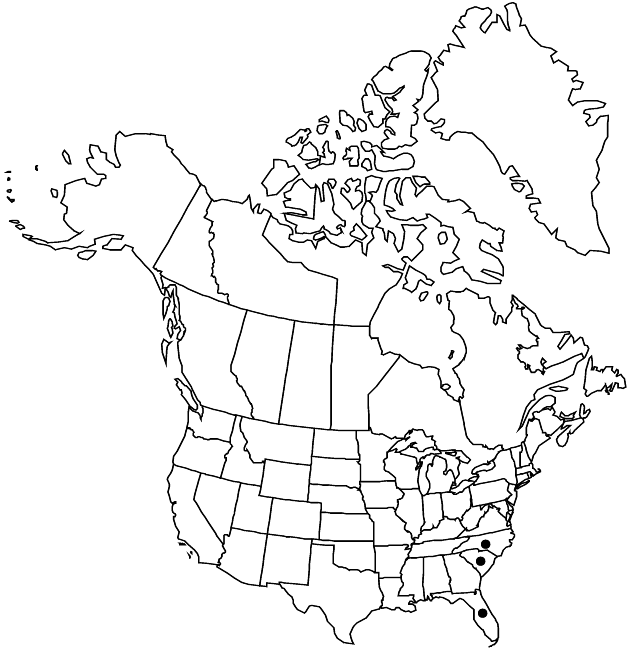Difference between revisions of "Symphyotrichum simmondsii"
Phytologia 77: 291. 1995.
FNA>Volume Importer |
FNA>Volume Importer |
||
| Line 11: | Line 11: | ||
|name=Aster simmondsii | |name=Aster simmondsii | ||
|authority=Small | |authority=Small | ||
| + | |rank=species | ||
|publication_title=Fl. Miami, | |publication_title=Fl. Miami, | ||
|publication_place=190, 200. 1913 | |publication_place=190, 200. 1913 | ||
| Line 38: | Line 39: | ||
-->{{#Taxon: | -->{{#Taxon: | ||
name=Symphyotrichum simmondsii | name=Symphyotrichum simmondsii | ||
| − | |||
|authority=(Small) G. L. Nesom | |authority=(Small) G. L. Nesom | ||
|rank=species | |rank=species | ||
| Line 53: | Line 53: | ||
|publication year=1995 | |publication year=1995 | ||
|special status= | |special status= | ||
| − | |source xml=https://jpend@bitbucket.org/aafc-mbb/fna-data-curation.git/src/ | + | |source xml=https://jpend@bitbucket.org/aafc-mbb/fna-data-curation.git/src/eaa6e58056e40c9ef614d8f47aea294977a1a5e9/coarse_grained_fna_xml/V19-20-21/V20_1147.xml |
|tribe=Asteraceae tribe Astereae | |tribe=Asteraceae tribe Astereae | ||
|genus=Symphyotrichum | |genus=Symphyotrichum | ||
Revision as of 19:24, 16 December 2019
Perennials, 10–120 cm, colonial (sometimes extensively); long-rhizomatous. Stems 1–3+, erect (straight, rigid, sometimes stout), sparsely scabrellous or glabrescent to glabrate or glabrous. Leaves firm, margins recurved, scabrous to scabrellous, apices acute to acuminate, mucronulate, abaxial faces pilosulous to glabrate or glabrous, midveins marked, adaxial scabridulous; basal withering by flowering, petiolate (petioles winged, bases sheathing), blades oblanceolate, 26–80 × 6–16 mm, bases attenuate, margins serrate, apices obtuse to acute; proximal cauline mostly withering by flowering, petiolate to subpetiolate (petioles winged, sheathing to clasping), blades elliptic to oblanceolate or lanceolate or lanceolate-linear to sometimes linear, 45–70+ × 8–15 mm, bases attenuate to cuneate, margins serrate or crenate-serrate or entire; distal (erect or spreading) sessile, blades lanceolate or oblanceolate to linear, 10–120 × 5–8 mm, reduced distally, sharply so on array branches, bases attenuate to cuneate, margins serrulate or entire. Heads in racemiform to usually open, sometimes ± lax, paniculiform arrays, rarely borne singly, branches ascending to spreading, often straggling and arched, ± leafy (each usually with 10+ heads), secondaries sometimes erect and secund-like. Peduncles 0.3–6+ cm, irregular in length along branches, sometimes distally reduced, glabrate to sparsely scabridulous, bracts 7–12+, spreading to ascending, abruptly reduced distally, grading into phyllaries. Involucres campanulate to campanulo-turbinate, (4.5–)6–8 mm. Phyllaries in 5–6 series, oblong-lanceolate to linear-lanceolate or lanceolate (innermost), strongly unequal, bases indurate 1/2–4/5, margins narrowly scarious, distally erose, hyaline, ciliolate, green zones oblanceolate (outer sometimes ± foliaceous), apices acute (inner sometimes acuminate), mucronate, often purplish tipped, faces glabrous. Ray florets 18–38; corollas pale lilac or lavender to pale purple, laminae 9–11 × 0.9–1.7 mm. Disc florets 24–37; corollas yellow becoming reddish, 4.5–7 mm, tubes shorter than funnelform throats, lobes lanceolate, 0.9–1 mm. Cypselae tan, oblong-obovoid to fusiform-obovoid, compressed, 2–2.6 mm, 4–6-nerved, faces ± strigillose; pappi cream, 4.6–6.5 mm. 2n = 64.
Phenology: Flowering Oct–Jan.
Habitat: Moist or dry soils
Elevation: 0–50 m
Distribution

Fla., N.C., S.C.
Discussion
Symphyotrichum simmondsii is known only from peninsular Florida and the southeastern coastal plain. A report from New Jersey is based on an incomplete specimen and appears doubtful.
Selected References
None.